The JCMA maintains a collection of over 700 objects, predominantly two-dimensional
works. At its core is the Stottlemyer collection, a 1998 gift to Juniata College by
Quayton Stottlemyer, Juniata College class of 1951, in honor of his father. Acquisition
of this large and varied collection spurred the development of the Museum and the
renovation of exhibition spaces in Carnegie Hall to accommodate presentation of both
permanent collection objects and temporary exhibitions. Since that time, the JCMA
collection has expanded through gifts and strategic purchases to provide students
and the surrounding community with opportunities to consider the breadth and diversity
of human expression through artistic endeavor.
Key holdings in the painting collection include American landscapes from the Hudson
River School, still lifes and portraits; small-scale European genre scenes of the
17th – 19th centuries; a collection of 18th – 20th century portrait miniatures; and
Modern and Contemporary works by Günther Spaltmann, Robert Birmelin, Romare Bearden,
and Richard Mayhew.
Works on paper showcase a variety of techniques, including etchings by such well-known
artists as Rembrandt and James McNeil Whistler; drawings and watercolors by the 19th
century American artists Thomas and Edward Moran; Japanese woodblock prints by Kunisada
and Hiroshige; oil color lithographs by George Baxter; print illustrations for Historic
Churches of America (1890); and a growing collection of contemporary works.
Juniata College is home to The Peace Chapel, a site-specific environmental work designed
by artist/architect Maya Lin in 1988-89. Located on a hillside just east of campus,
the Chapel is open to the public and is accessible by marked walking trails.
Stottlemyer Collection
In 1998 Juniata College accepted the gift of the Worth B. Stottlemyer Collection and renovated its existing exhibition galleries in Carnegie Hall to formally establish the JCMA. The Stottlemyer collection of over 500 works, which comprises the core of the JCMA permanent collection, includes 18th and 19th century American and European paintings, prints and drawings; 19th century Japanese color woodblock prints; and 18th – 20th century portrait miniatures.
The Stottlemyer Collection was given by Quayton Stottlemyer, Juniata class of 1951, in honor of his father, who amassed the works between 1927 and his death in 1951. For a complete history of this significant acquisition, consult The Stottlemyer Collection: A Journey (Mathur, Amy and Rosell, Karen, ed. Juniata College Museum of Art, 2014).
American Paintings
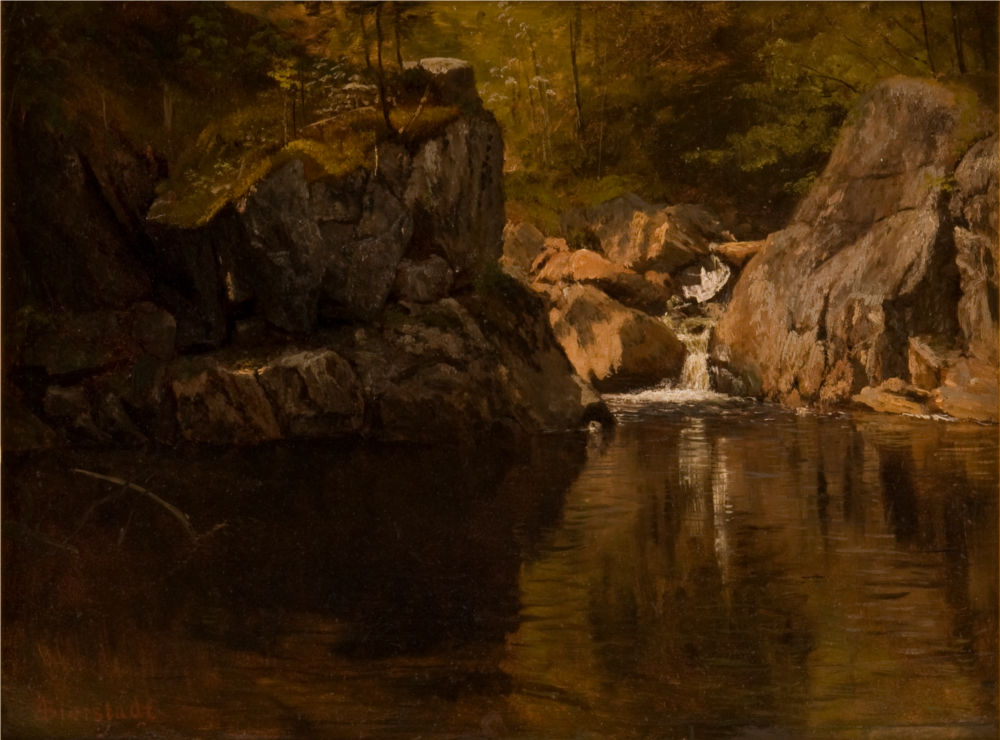
The JCMA permanent collection is strong in works by key members of the Hudson River School, including Thomas Cole, Asher B. Durand, Jervis McEntee, John Casilear, Albert Bierstadt, and John Kensett.
The collection also features nautical scenes by Edward Moran, animal paintings by Arthur Fitzwilliam Tate, and works by renowned still life painter of fruits and flowers, Severin Roesen, a German-born artist whose career flourished in Central Pennsylvania during the 19th century.
Portrait Miniatures
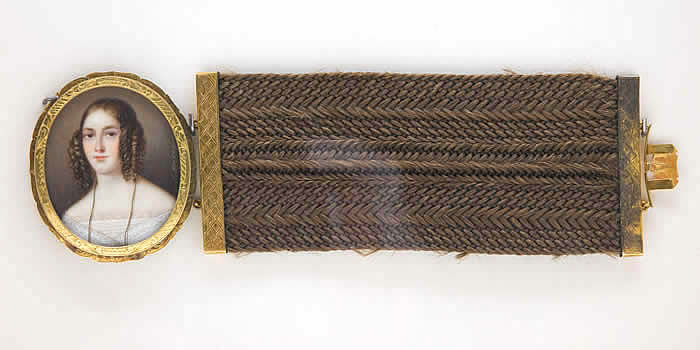
Among the treasures in the museum's collection is a group of over seventy portrait miniatures dating to the 18th – 20th centuries by American and European painters. Portrait miniature painting was particularly popular between 1750 and 1850, before the advent of photography; painters endeavored to capture the individual character of the sitter in watercolor on thin disks of ivory. Portrait miniatures in the group take the form of pendants, brooches, small framed pictures, and rings. The cases of many portrait miniatures contain a small glass-covered opening to house a lock of the sitter's hair.
European Paintings
The JCMA collection includes small selection of paintings by French, English, Dutch, and Italian artists of the 18th – 20th centuries. Works in this group are the focus of ongoing efforts in conservation, as exemplified by a painting attributed to 18th-century Italian artist Giovanni Battista Tiepolo.
Works on Paper
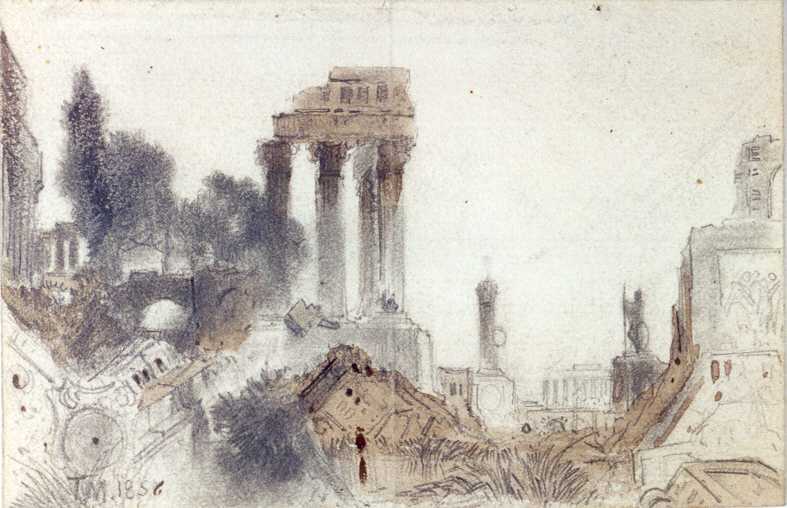
Works on paper – including drawings, watercolors, etchings, engravings, woodcuts, and lithographs – comprise the greatest portion of the Museum’s collection. Many complement the painting collection, with works by Thomas Cole, and Edward, Thomas, Peter, and Mary Nimmo Moran. Others represent the work of well-known artists from the 17th – 21st centuries, including Rembrandt, James Abbott McNeill Whistler, Philip Pearlstein, Romare Bearden, and Richard Mayhew. The collection also includes select 18th-century Japanese woodblock prints of the ukiyo-e (images of the floating world) genre.
20th Century/Contemporary
The JCMA continues to acquire works representing the art of our time in diverse media. Key acquisitions include work by Robert Birmelin, Alexander McBride, Stephen Barbash, and Robert Lugo.
Navajo Textiles
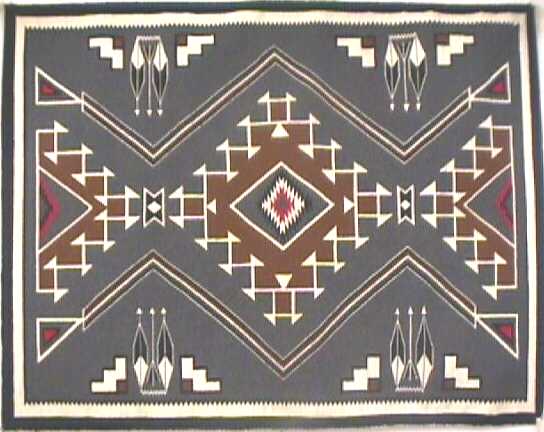
An unexpected part of the JCMA collection is a group of 20th century Navajo textiles, given to the Museum by collector Edwin L. Kennedy during his tenure on the Board of Trustees of Juniata College. The titles given to the rugs often refer to regional styles and locations near major trading posts, for example, Ganado and Two Grey Hills. The geometric patterns woven into these textiles are often archetypal and symbolic in meaning. Earth, sky, day, night, hills, and canyons are popular imagery.
Maya Lin's Peace Chapel
The Peace Chapel is an environmental landscape site designed by architect Maya Lin. It occupies a 14-acre site within the 170-acre Baker-Henry Nature Preserve. Located near the Juniata College campus, the Peace Chapel provides a contemplative setting within the rolling hills of central Pennsylvania.
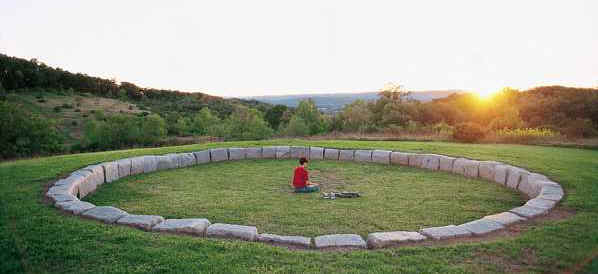
Designed and constructed in 1988-1989, the Peace Chapel consists of two sites. The larger site is defined by a 40-foot circle of rough granite stones that line a shallow well at the top of a hill. A series of smoothly polished granite steps lead from the footpath up to the circle of stones. The smaller site occupies the top of a slightly higher neighboring hill. This smaller site consists of a 4-food diameter smooth granite disk set within the forest that blankets the hill. From the disk one can peer through the trees to the distant hill and view the larger circle of stones.
The Peace Chapel was created through the generous support of Elizabeth Evans Baker and John Calhoun Baker (Juniata Class of 1917).
Other Works by Maya Lin
- The Vietnam Veterans Memorial, Washington, D.C.
- Civil Rights Memorial, Montgomery, Alabama
- The Women's Table, Yale University, New Haven, Connecticut
The Peace Chapel is open daily from dawn to dusk. Please contact the Juniata College Museum of Art (814-641-3505).
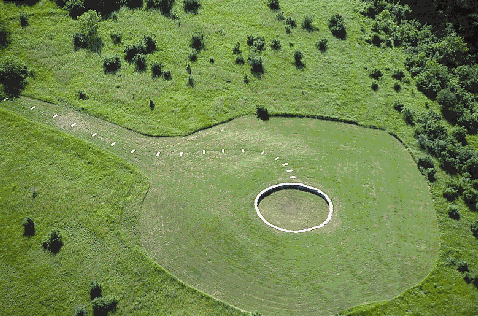
Directions
From State College and North-Central Pennsylvania (45 miles from State College)
- PA Route 26 South to Huntingdon
- As you approach Huntingdon, watch for signs to the hospital (a blue "H") and a right directional sign for Petersburg. These signs direct to Cold Springs Road.
- Turn Right onto Cold Springs Road.
- Follow Cold Springs Road for several miles.
- Turn Left onto Warm Springs Avenue (if you see the entrance sign to Westminster Woods, you have gone too far).
- Travel four blocks and Turn Left onto Peace Chapel Road.
- Parking is located 200 yards on the right.
From Pittsburgh and Western Pennsylvania (117 miles from Pittsburgh)
- US Route 22 East to Huntingdon
- In Huntingdon, left onto 4th Street (major intersection with traffic lights and location of Raystown Shopping Center)
- Left onto Penn Street
- Right onto 6th Street
- Left onto Moore Street
- Continue on Moore Street through town and past Juniata College (between 17th and 19th streets).
- Once past the College turn right at the stop sign onto Cold Springs Road.
- Continue on Cold Springs Road After passing Westminster Woods, prepare to turn right.
- Turn Right onto Warm Springs Avenue.
- Travel four blocks and Turn Left onto Peace Chapel Road.
- Parking is located 200 yards on the right.
From Easton, Harrisburg and Eastern Pennsylvania (93 miles from Harrisburg)
- US Route 78 West to Harrisburg
- Follow signs to Lewistown on US I-283 North
- In Lewistown, take US Route 22 West to Huntingdon
- In Huntingdon, turn right onto 4th Street (major intersection with traffic lights and location of Raystown Shopping Center)
- Left onto Penn Street
- Right onto 6th Street
- Left onto Moore Street
- Continue on Moore Street through town and past Juniata College (between 17th and 19th streets).
- Once past the College turn right at the stop sign onto Cold Springs Road.
- Continue on Cold Springs Road, after passing Westminster Woods, prepare to turn right.
- Turn Right onto Warm Springs Avenue.
- Travel four blocks and Turn Left onto Peace Chapel Road.
- Parking is located 200 yards on the right.
From Washington, D.C. and Maryland (151 miles from Washington, D.C.)
- US I-70 West to Hagerstown
- US 1-80 north to Greencastle
- PA Route 16 to McConnellsburg
- US Route 522 North to Mt. Union
- US Route 22 West to Huntingdon
- In Huntingdon, turn right onto 4th Street (major intersection with traffic lights and location of Raystown Shopping Center)
- Left onto Penn Street
- Right onto 6th Street
- Left onto Moore Street
- Continue on Moore Street through town and past Juniata College (between 17th and 19th streets).
- Once past the College turn right at the stop sign onto Cold Springs Road.
- Continue on Cold Springs Road, after passing Westminster Woods, prepare to turn right.
- Turn Right onto Warm Springs Avenue.
- Travel four blocks and Turn Left onto Peace Chapel Road.
- Parking is located 200 yards on the right.

